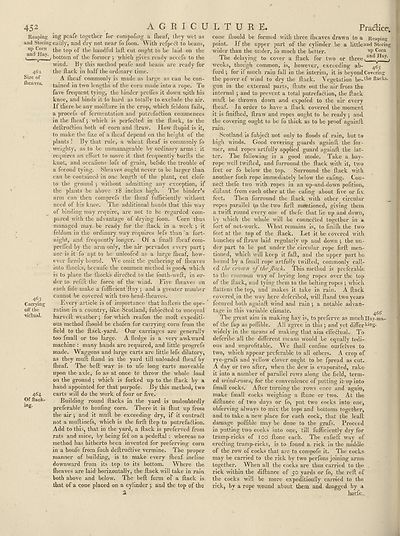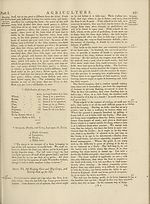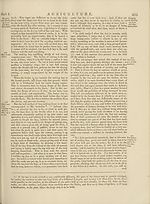Encyclopaedia Britannica, or, a Dictionary of arts, sciences, and miscellaneous literature : enlarged and improved. Illustrated with nearly six hundred engravings > Volume 1, A-AME
(480) Page 452
Download files
Complete book:
Individual page:
Thumbnail gallery: Grid view | List view

452
Reaping
and Storin'
up Corn
and Hay.
462
Size of
flieaves.
A G E I C U L T U R E.
4^3
Carrying
oft’ the
■victual.
46'4
Of flack¬
ing.
ing peafe together for compofmg a flieaf, they wet as
; eaiily, and dry not near fo foon. With refpeft to beans,
the top of the handful lall cut ought to be laid on the
1 bottom of the former 5 which gives ready aceefs to the
wind. By this method peafe and beans are ready for
the Hack in half the ordinary time.
A flieaf commonly is made as large as can be con¬
tained in two lengths of the corn made into a rope. To
fave frequent tying, the binder prefl’es it down with his
knee, and binds it lo hard as totally to exclude the air.
If there be any moifture in the crop, which feldom fails,
a procefs of fermentation and putrefaction commences
in the flieaf; which is perfected in the Hack, to the
deflruCtion both of corn and Hraw. How flnpid is it,
to make the fize of a llicaf depend on the height of the
plants ! By that rule, a wheat flieaf is commonly fo
weighty, as to be unmanageable by ordinary arms: it
requires an effort to move it that frequently burffs the
knot, and occalions iofs of grain, behde the trouble of
a fecond tying. Sheaves ought never to be larger than
can be contained in one length of the plant, cut clofe
to the ground ; without admitting any exception, if
the plants be above 18 inches, high. The binder’s
arm can then comprefs the flieaf fufficiently without
need of his knee. The additional (lands that this way
of binding may require, are not to be regarded com¬
pared with the advantage of drying foon. Corn thus
managed may be ready for the Hack in a week ; it
feldom in the ordinary way requires lefs than 'a fort¬
night, and frequently longer. Of a finall flieaf com-
preffed by the arm only, the air pervades every part
nor is it fo apt to be unloofed as a large flieaf, how¬
ever firmly bound. We omit the gathering of flieaves
into lliocks, becaufe the common method is good* which
is to place the fliocks directed to the fouth-weff, in or¬
der to refiH the force of the wind. Five flieaves on
each lide make a fufficient Hay ; and a greater number
cannot be covered with two head-flieaves.
Every article is of importance that haHens the ope¬
ration in a country, like Scotland, fubjeCted to unequal
harvell weather •, for which reafon the moH expediti¬
ous method fliould be chofen for carrying corn from the
field to the Hack-yard. Our carriages are generally
too fmall or too large. A fledge is a very awkward
machine : many hands are required, and little progrefs
made. Waggons and large carts are little lefs dilatory,
as they muH Hand in the yard till unloaded flieaf by
flieaf. The beH way is to ufe long carts moveable
upon the axle, fo as at once to throw the whole load
on the ground; which is forked up to the Hack by a
hand appointed for that purpofe. By this method, two
carts will do the work of four or five.
Building round Hacks in the yard is undoubtedly
preferable to houfing corn. There it is fhut up from
the air } and it muH be exceeding dry, if it contraft
not a muHinefs, which is the firft Hep to putrefaHion.
Add to this, that in the yard, a Hack is preferved from
rats and mice, by being fef on a pedellal : whereas no
method has hitherto been invented for preferving corn
in a houfe from fuoh deHructive vermine. The proper
manner of building, is to make every flieaf incline
downward from its top to its bottom. Where the
flieaves are laid horizontally, the Hack will take in rain
both above and below. The beH form of a Hack is
that of a cone placed on a cylinder j and the top of the
Practice,
cone fliould be formed with three flitaves drawn to a Reaping
point. If the upper part of the cylinder be a little and Storing
wider than the under, fo much the better. ’'P t'orn
Y he delaying to cover a Hack for two or three, anc^^ay-i
w'eeks, though common, is, however, exceeding ab- ^4-
furd } for it much rain fall in the interim, it is beyond Covering
the power of wind to dry the Hack. Vegetation be-th6 flacks,
gun in the external parts, flints out the air from the
internal 5 and to prevent a total putrefaction, the Hack
muH be thrown down and expofed to the air every
flieaf. In order to have a Hack covered the moment
it is finillied, Hraw and ropes ought to be ready 5 and
the covering ought to be fo thick as to be proof againfl
rain.
Scotland is fubject not only to floods of rain, hut t®
high winds. Good covering guards againll the for¬
mer, and ropes artfully applied guard againH the lat¬
ter. The following is a good mode. Take a hay-
rope wTell twiHed, and furround the Hack with it, two
feet or fo below the top. Surround the Hack with
another fuch rope immediately below the eaiing. Con-
nedt thefe two with ropes in an up-and-down pofition,
dillant from each other at the eafmg about five or fix
feet. Then furround the Hack with other circular
ropes parallel tyi the two firfi mentioned, giving them
a twill round every one of thefe that lie up and down,
by winch the whole wrill be connected together in a
fort of net-work. W hat remains is, to finifli the two
feet at the top of the Hack. Let it be covered with
bunches of flraw laid regularly up and down ; the un¬
der part to be put under the circular rope firfl men¬
tioned, which will keep it faH, and the upper part be
hound by a imall rope artfully twiHed, commonly call¬
ed the crown of the Jtach. This method is preferable
to the common way of laying long ropes over the top
of the Hack, and tying them to the belting ropes ; which
flattens the top, and makes it take in rain. A Hack
covered, in the way here deferibed, will Hand two years
fccured both againH wind and rain } a notable advan¬
tage in this variable climate. ^
The great aim in making hay is, to preferve as much Xlay-ma-
ol the fap as pollible. All agree in this ; and yet differing,
widely in. the means of making that aim effe&uaL To
deferibe all the different means would be equally tedi¬
ous and unprofitable. We lliall confine ourfelves to
tw’o, which appear preferable to all others. A crop of
rye-grafs and yellow clover ought to be fpread as cut.
A day or two after, when the dew is evaporated, rake
it into a number of parallel rows along the field, term¬
ed wind-rows, for the convenience of putting it up into
Imall cocks. After turning the rows once and again,
make fmall cocks weighing a Hone or twTo. At the
diHance of two days or fo, put two cocks into one,
obferving always to mix the tops and bottoms together,
and to take a new place for each eock, that the leall
damage poflibre may he done to the grafs. Proceed
in putting two cocks into one, till fufficiently dry for
tramp-ricks of 100 Hone each. The eafieH way of
erefting tramp-ricks, is to found a rick in the middle
ot the row of cocks that are to compofe it. The cocks
may be carried to the rick by two perfons joining arms
together. When all the cocks are thus carried to the
rick within the diflance of 50 yards or fo, the reH of
the cocks will be more expeditioufly carried to the
rick, by a rope wound about them and dragged by a
horfe,,.
Reaping
and Storin'
up Corn
and Hay.
462
Size of
flieaves.
A G E I C U L T U R E.
4^3
Carrying
oft’ the
■victual.
46'4
Of flack¬
ing.
ing peafe together for compofmg a flieaf, they wet as
; eaiily, and dry not near fo foon. With refpeft to beans,
the top of the handful lall cut ought to be laid on the
1 bottom of the former 5 which gives ready aceefs to the
wind. By this method peafe and beans are ready for
the Hack in half the ordinary time.
A flieaf commonly is made as large as can be con¬
tained in two lengths of the corn made into a rope. To
fave frequent tying, the binder prefl’es it down with his
knee, and binds it lo hard as totally to exclude the air.
If there be any moifture in the crop, which feldom fails,
a procefs of fermentation and putrefaction commences
in the flieaf; which is perfected in the Hack, to the
deflruCtion both of corn and Hraw. How flnpid is it,
to make the fize of a llicaf depend on the height of the
plants ! By that rule, a wheat flieaf is commonly fo
weighty, as to be unmanageable by ordinary arms: it
requires an effort to move it that frequently burffs the
knot, and occalions iofs of grain, behde the trouble of
a fecond tying. Sheaves ought never to be larger than
can be contained in one length of the plant, cut clofe
to the ground ; without admitting any exception, if
the plants be above 18 inches, high. The binder’s
arm can then comprefs the flieaf fufficiently without
need of his knee. The additional (lands that this way
of binding may require, are not to be regarded com¬
pared with the advantage of drying foon. Corn thus
managed may be ready for the Hack in a week ; it
feldom in the ordinary way requires lefs than 'a fort¬
night, and frequently longer. Of a finall flieaf com-
preffed by the arm only, the air pervades every part
nor is it fo apt to be unloofed as a large flieaf, how¬
ever firmly bound. We omit the gathering of flieaves
into lliocks, becaufe the common method is good* which
is to place the fliocks directed to the fouth-weff, in or¬
der to refiH the force of the wind. Five flieaves on
each lide make a fufficient Hay ; and a greater number
cannot be covered with two head-flieaves.
Every article is of importance that haHens the ope¬
ration in a country, like Scotland, fubjeCted to unequal
harvell weather •, for which reafon the moH expediti¬
ous method fliould be chofen for carrying corn from the
field to the Hack-yard. Our carriages are generally
too fmall or too large. A fledge is a very awkward
machine : many hands are required, and little progrefs
made. Waggons and large carts are little lefs dilatory,
as they muH Hand in the yard till unloaded flieaf by
flieaf. The beH way is to ufe long carts moveable
upon the axle, fo as at once to throw the whole load
on the ground; which is forked up to the Hack by a
hand appointed for that purpofe. By this method, two
carts will do the work of four or five.
Building round Hacks in the yard is undoubtedly
preferable to houfing corn. There it is fhut up from
the air } and it muH be exceeding dry, if it contraft
not a muHinefs, which is the firft Hep to putrefaHion.
Add to this, that in the yard, a Hack is preferved from
rats and mice, by being fef on a pedellal : whereas no
method has hitherto been invented for preferving corn
in a houfe from fuoh deHructive vermine. The proper
manner of building, is to make every flieaf incline
downward from its top to its bottom. Where the
flieaves are laid horizontally, the Hack will take in rain
both above and below. The beH form of a Hack is
that of a cone placed on a cylinder j and the top of the
Practice,
cone fliould be formed with three flitaves drawn to a Reaping
point. If the upper part of the cylinder be a little and Storing
wider than the under, fo much the better. ’'P t'orn
Y he delaying to cover a Hack for two or three, anc^^ay-i
w'eeks, though common, is, however, exceeding ab- ^4-
furd } for it much rain fall in the interim, it is beyond Covering
the power of wind to dry the Hack. Vegetation be-th6 flacks,
gun in the external parts, flints out the air from the
internal 5 and to prevent a total putrefaction, the Hack
muH be thrown down and expofed to the air every
flieaf. In order to have a Hack covered the moment
it is finillied, Hraw and ropes ought to be ready 5 and
the covering ought to be fo thick as to be proof againfl
rain.
Scotland is fubject not only to floods of rain, hut t®
high winds. Good covering guards againll the for¬
mer, and ropes artfully applied guard againH the lat¬
ter. The following is a good mode. Take a hay-
rope wTell twiHed, and furround the Hack with it, two
feet or fo below the top. Surround the Hack with
another fuch rope immediately below the eaiing. Con-
nedt thefe two with ropes in an up-and-down pofition,
dillant from each other at the eafmg about five or fix
feet. Then furround the Hack with other circular
ropes parallel tyi the two firfi mentioned, giving them
a twill round every one of thefe that lie up and down,
by winch the whole wrill be connected together in a
fort of net-work. W hat remains is, to finifli the two
feet at the top of the Hack. Let it be covered with
bunches of flraw laid regularly up and down ; the un¬
der part to be put under the circular rope firfl men¬
tioned, which will keep it faH, and the upper part be
hound by a imall rope artfully twiHed, commonly call¬
ed the crown of the Jtach. This method is preferable
to the common way of laying long ropes over the top
of the Hack, and tying them to the belting ropes ; which
flattens the top, and makes it take in rain. A Hack
covered, in the way here deferibed, will Hand two years
fccured both againH wind and rain } a notable advan¬
tage in this variable climate. ^
The great aim in making hay is, to preferve as much Xlay-ma-
ol the fap as pollible. All agree in this ; and yet differing,
widely in. the means of making that aim effe&uaL To
deferibe all the different means would be equally tedi¬
ous and unprofitable. We lliall confine ourfelves to
tw’o, which appear preferable to all others. A crop of
rye-grafs and yellow clover ought to be fpread as cut.
A day or two after, when the dew is evaporated, rake
it into a number of parallel rows along the field, term¬
ed wind-rows, for the convenience of putting it up into
Imall cocks. After turning the rows once and again,
make fmall cocks weighing a Hone or twTo. At the
diHance of two days or fo, put two cocks into one,
obferving always to mix the tops and bottoms together,
and to take a new place for each eock, that the leall
damage poflibre may he done to the grafs. Proceed
in putting two cocks into one, till fufficiently dry for
tramp-ricks of 100 Hone each. The eafieH way of
erefting tramp-ricks, is to found a rick in the middle
ot the row of cocks that are to compofe it. The cocks
may be carried to the rick by two perfons joining arms
together. When all the cocks are thus carried to the
rick within the diflance of 50 yards or fo, the reH of
the cocks will be more expeditioufly carried to the
rick, by a rope wound about them and dragged by a
horfe,,.
Set display mode to:
![]() Universal Viewer |
Universal Viewer | ![]() Mirador |
Large image | Transcription
Mirador |
Large image | Transcription
Images and transcriptions on this page, including medium image downloads, may be used under the Creative Commons Attribution 4.0 International Licence unless otherwise stated. ![]()
| Permanent URL | https://digital.nls.uk/193138225 |
|---|
| Attribution and copyright: |
|
|---|
| Description | Ten editions of 'Encyclopaedia Britannica', issued from 1768-1903, in 231 volumes. Originally issued in 100 weekly parts (3 volumes) between 1768 and 1771 by publishers: Colin Macfarquhar and Andrew Bell (Edinburgh); editor: William Smellie: engraver: Andrew Bell. Expanded editions in the 19th century featured more volumes and contributions from leading experts in their fields. Managed and published in Edinburgh up to the 9th edition (25 volumes, from 1875-1889); the 10th edition (1902-1903) re-issued the 9th edition, with 11 supplementary volumes. |
|---|---|
| Additional NLS resources: |
|

